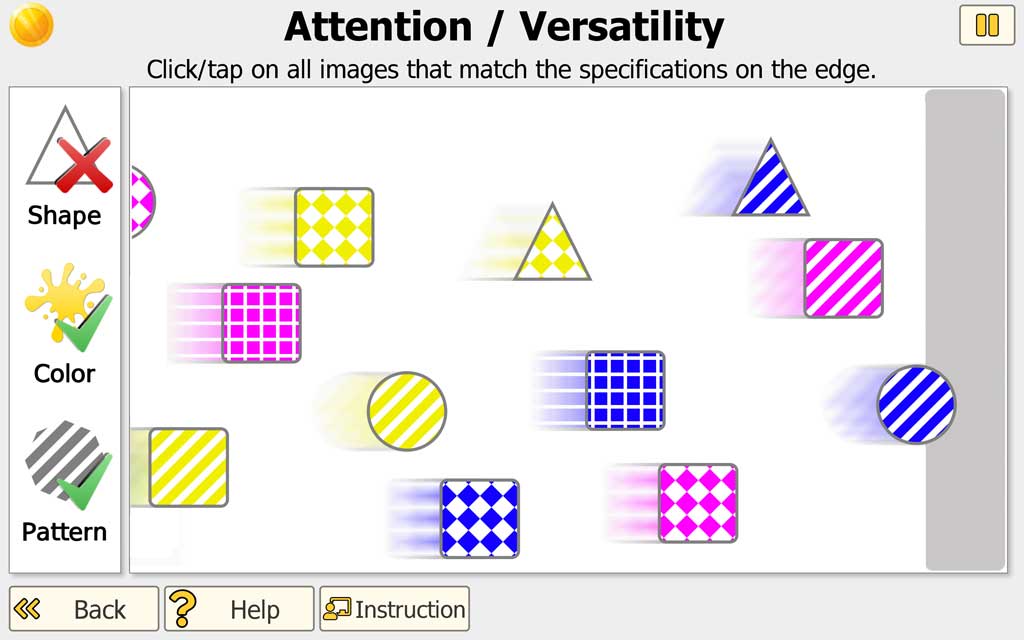
































































Training goal
The program trains attention and concentration. Attention is one of the most important basic services of the brain because it is essential. NEUROvitalis trains all areas of attention performance: “selectivity” and “intensity”.
Attention selectivity
A distinction is made between 3 sub-areas:
Selective / focused attention
Selective or focused attention refers to the ability to focus attention on one thing and hide everything else around it.
In this training, the focus is on the objects and their characteristics. The trainee must constantly compare new objects with the given specifications and select objects that do not meet the specifications.
Divided attention
The second type of attention selectivity is divided attention. This means the ability to observe or react to two or more things at the same time.
In this training the objects change constantly. It is not enough to apply what you have learned; in higher levels, the target stimuli change several times during a task.
Spatial-visual attention
The third type of attention selectivity is visual-spatial selective attention. Attention is shifted to a new thing.
New objects appear constantly in training, others leave the screen. Attention must always be directed to another source.
Attention intensity
Activation
Activation is the general alertness of a person. That is, a person is able to react to various stimuli.
In this training, active attention is required to solve the task.
Information processing speed
The second type of attention intensity is the information processing speed. If this is disturbed, it can lead to mental slowdown. This means that information can no longer be processed and reacted as quickly as necessary.
The speed and frequency with which the stimuli appear depends on the level of difficulty of the training. Initially, few stimuli are used that run slowly across the screen. The number and speed increase in higher levels of difficulty.
Long term attention
The third type is long term attention. As the name suggests, this describes an ongoing focus on a certain thing.
The longer the training lasts, the higher the demands on the patient’s permanent attention (see procedure -> training duration).
Versatility
The name “versatility” indicates that the players should think and react contrary to their habits. By inhibiting thinking routines in favor of a new way of thinking, concentration and attention are encouraged.
Task description
Depending on the level of difficulty, a different number of objects (stimuli) run across the screen. The objects have different shapes in different colors and are patterned differently at higher levels of difficulty.
From these stimuli, certain characters should be selected and tapped / clicked according to one or more specific features.
The stimuli flow either in the right or left direction, depending on the level at three different speeds.
At the edge of the window there is a small area in which errors are displayed. There are omissions and incorrectly marked stimuli. If the exerciser makes a mistake, the movement stops for a short time.
The characteristics according to which you want to select are shown on the edge. This can be color and / or shape and / or pattern. It is specified whether the stimuli sought must match this characteristic(s) or not. The characteristics change several times on some difficulty levels.
Procedure
In the start window for all therapy programs select the “All exercises” area, here the “NEUROvitalis” tab. Click on the training exercise “Memory – Vita Mem”.
A window appears for selecting the level of difficulty and the duration of the training.
Level of difficulty
So that the exerciser does not overwhelm himself, the training begins with a low level of difficulty. All other levels are locked with a lock, which must be opened by completing the previous task.
If a therapist wants to skip levels of difficulty, he can switch on the “Therapist can start all levels” option in the “Patient -> Edit” menu.
Training duration
In general, 20 minutes of training is recommended. A too long training session leads to a loss of attention, the patient makes mistakes and becomes frustrated.
For severely affected people, the training duration should e.g. reduced to 10 minutes (attention span). In this case, several sessions a day make sense.
Scroll direction
During exercise, the objects move horizontally across the screen, from left to right by default.
You can change the direction of scroll to “to the left”, e.g. when it’s required due to a neglect.
Progress in therapy
The therapy progress is saved automatically. A new session continues with the difficulty in which the last session ended.
The “Results” window offers various views of the course of therapy (button at the bottom of the “Therapy modules” window).

